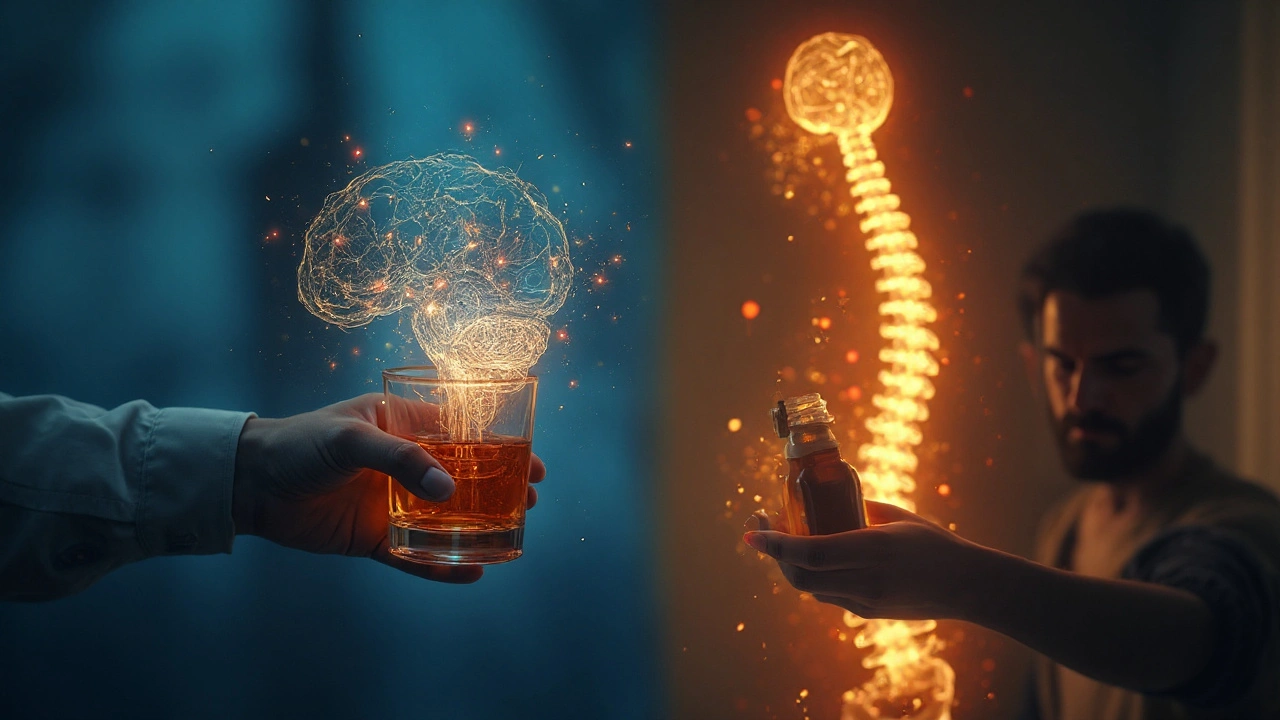Alcoholism‑Chronic Pain Connection is a complex, bidirectional relationship where heavy alcohol use can intensify persistent pain, and chronic pain can drive increased drinking. People often think of alcohol as a simple way to dull pain, but over time the body adapts, creating a vicious loop that makes both conditions harder to break.
What Is Alcoholism?
Alcoholism is a chronic disease characterized by an inability to control alcohol consumption despite negative health, social, or occupational consequences. In Australia, roughly 2.5% of adults meet criteria for alcohol dependence, and the prevalence climbs higher among patients who regularly visit pain clinics. The disorder is not just a habit; it reshapes brain chemistry, especially the reward pathways that also process pain signals.
Understanding Chronic Pain
Chronic Pain is a persistent pain lasting longer than three months, often without a clear, treatable injury. Conditions such as osteoarthritis, fibromyalgia, and neuropathy fall under this umbrella. Unlike acute pain, chronic pain keeps the nervous system in a heightened state of alert, making even mild stimuli feel excruciating.
Biological Pathways Linking Alcoholism and Chronic Pain
Three main mechanisms keep the two conditions intertwined:
- Neuroinflammation: Excess alcohol triggers the release of inflammatory cytokines in the brain and spinal cord. These molecules sensitize nociceptors - the nerves that signal pain - creating a feedback loop. Studies from the National Institute on Alcohol Abuse and Alcoholism (NIAAA) show that regular drinkers have 30% higher levels of C‑reactive protein, a marker linked to chronic pain.
- Pain Sensitization: Long‑term ethanol exposure up‑regulates NMDA receptors, which are central to central sensitization. The result is a lower pain threshold, meaning everyday activities can become painful.
- Altered Endogenous Opioid System: Alcohol temporarily boosts endorphin release, but chronic use depletes the system. When the body’s natural painkillers run low, patients often turn to external opioids, raising the risk of Opioid Use Disorder and a phenomenon called opioid‑induced hyperalgesia.
Psychological Overlap: Depression, Anxiety, and Co‑morbidities
The mental health side of the equation is just as powerful. Depression affects up to 50% of people with chronic pain, and alcohol is often used as a self‑medication tool. Anxiety follows a similar pattern, amplifying muscle tension and migraine frequency. The co‑occurrence of these disorders makes diagnosis tricky-clinicians may treat the pain, miss the alcohol dependence, or vice‑versa.
Clinical Implications: Diagnosis and Treatment Challenges
When a patient walks into a clinic with a sore back and a history of nightly drinks, the provider faces several hurdles:
- Screening Accuracy: Standard pain questionnaires rarely ask about alcohol quantity. Adding a brief AUDIT‑C (Alcohol Use Disorders Identification Test‑Consumption) can catch hidden misuse.
- Medication Interactions: Many analgesics, especially NSAIDs, increase gastrointestinal bleeding risk when combined with alcohol.
- Risk of Substitution: Cutting back on alcohol without offering alternative coping strategies often leads patients to higher opioid doses, spiralling into Substance Use Disorder.

Comparison: Alcoholism‑Related Pain vs Opioid‑Induced Hyperalgesia
| Aspect | Alcoholism‑Related Pain | Opioid‑Induced Hyperalgesia |
|---|---|---|
| Primary Trigger | Chronic ethanol exposure | Long‑term opioid analgesics |
| Underlying Mechanism | Neuroinflammation & NMDA up‑regulation | Opioid receptor desensitization |
| Typical Onset | Months to years of heavy drinking | Weeks to months of high‑dose opioids |
| Management Strategy | Alcohol cessation + multidisciplinary pain therapy | Opioid taper + non‑opioid analgesics |
| Co‑morbid Risks | Liver disease, depression | Respiratory depression, overdose |
Integrated Pain Management Strategies
Breaking the cycle requires a blend of medical, psychological, and lifestyle interventions:
- Medication‑Assisted Treatment (MAT): Drugs like naltrexone block alcohol cravings while also modulating opioid receptors, offering dual benefit for many patients.
- Cognitive‑Behavioral Therapy (CBT): Targets the thought patterns that link pain catastrophizing with drinking urges.
- Physical Rehabilitation: Low‑impact exercises (e.g., swimming, yoga) improve circulation, reduce inflammation, and provide a healthy distraction from alcohol.
- Nutrition & Sleep Hygiene: Adequate protein supports nerve repair, and consistent sleep reduces cortisol spikes that heighten pain sensitivity.
Importantly, clinicians should adopt the “Pain Management as a chronic disease model”-treating it with the same long‑term monitoring and multidisciplinary care used for diabetes or hypertension.
Emerging Research and Future Directions
New findings suggest that targeting the gut‑brain axis might blunt both alcohol‑induced inflammation and pain perception. Probiotic trials in 2024 showed a 15% reduction in reported pain scores among participants with alcohol use disorder. Likewise, brain‑stimulating techniques like transcranial magnetic stimulation (TMS) are being explored to reset pain pathways without medication.
For policymakers, the data highlight why integrating addiction services into pain clinics could cut healthcare costs. In 2023, the Australian Department of Health reported a 22% drop in emergency admissions when patients received combined care.
Takeaway Checklist
- Screen every chronic‑pain patient for alcohol use (AUDIT‑C).
- Consider neuroinflammation markers when pain persists despite standard therapy.
- Prefer non‑opioid analgesics and MAT when alcohol dependence is present.
- Incorporate CBT and physical activity early to prevent substitution.
- Stay updated on gut‑brain research-dietary interventions may become part of standard protocols.
Frequently Asked Questions
Can occasional drinking worsen chronic pain?
Yes. Even moderate alcohol intake can increase inflammatory cytokines, which may amplify pain signals. People with existing chronic pain should discuss any alcohol use with their doctor.
Is it safe to use painkillers while trying to quit alcohol?
Many painkillers, especially NSAIDs, can irritate the stomach lining already compromised by alcohol. A clinician might recommend acetaminophen at safe doses or prescribe a non‑pharmacologic regimen instead.
What role does depression play in the alcoholism‑pain loop?
Depression lowers pain tolerance and drives self‑medication with alcohol. Treating depression with therapy or appropriate antidepressants often reduces both drinking frequency and pain intensity.
Are there non‑alcohol‑based ways to manage pain cravings?
Mind‑body approaches-such as mindfulness meditation, guided imagery, and progressive muscle relaxation-have shown promising results in diminishing the urge to drink for pain relief.
How quickly can neuroinflammation improve after quitting alcohol?
Research indicates measurable declines in C‑reactive protein within three months of sustained abstinence, though full neural recovery may take 12‑18 months depending on age and overall health.


Danielle Knox
September 24 2025Oh great, another article telling us that booze isn’t a miracle cure.